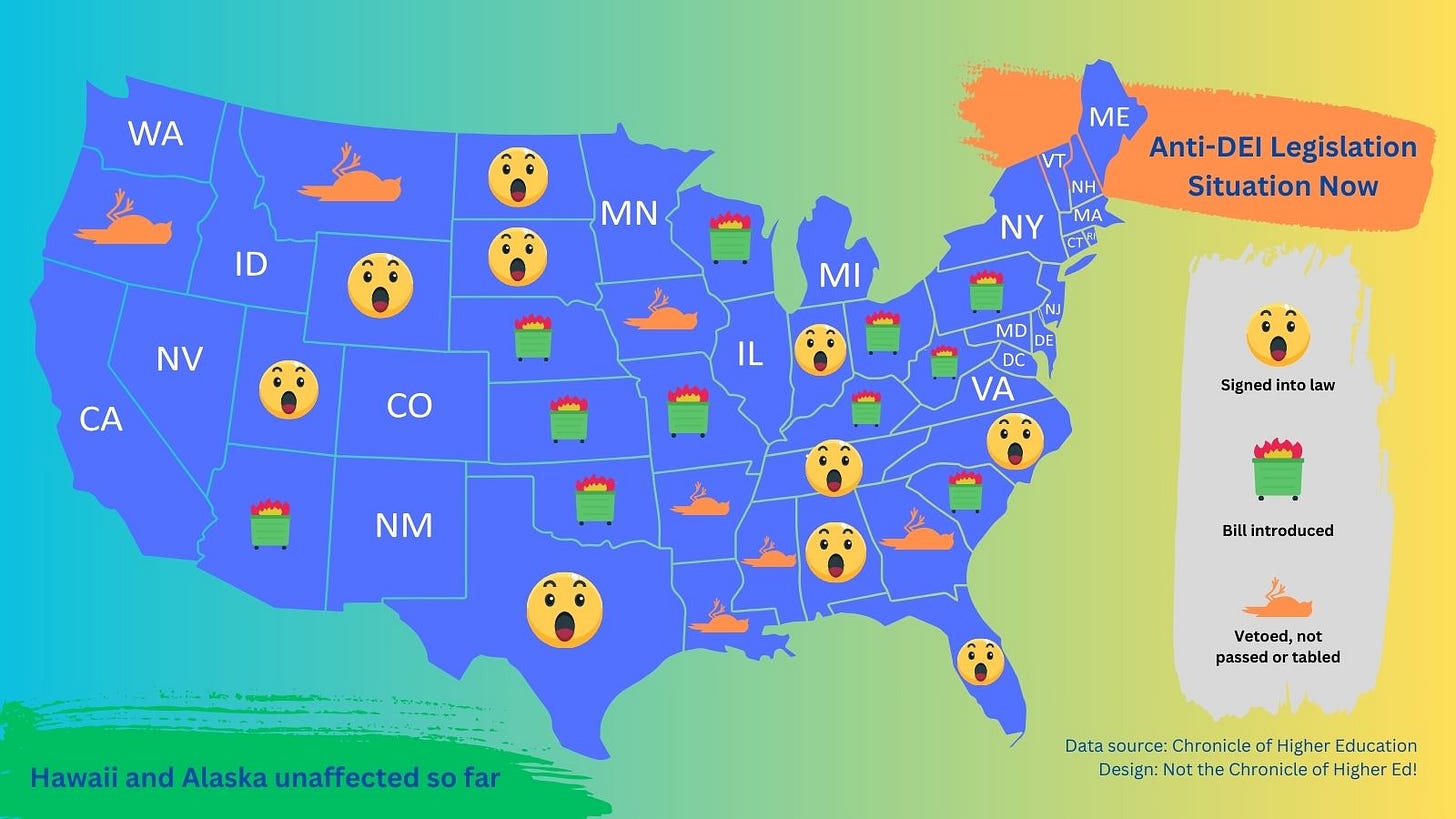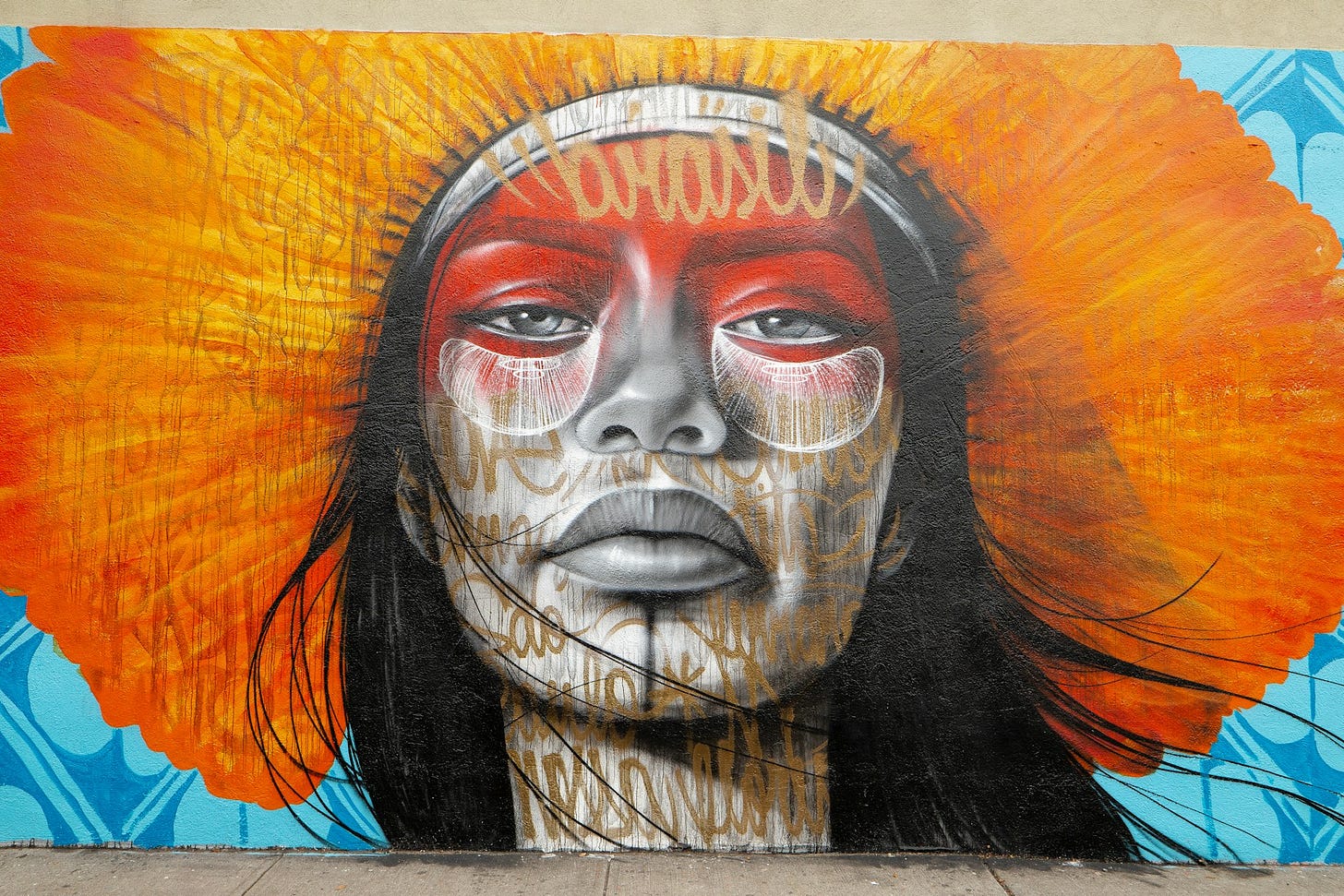We can't let anti-DEI laws kill public media
Legislation affects public radio and TV's efforts to serve communities
Last week, the University of Texas laid off 60 staffers to comply with a new state ban on DEI. 😔 Such an alarming trend has emerged across the United States, with dozens of bills targeting diversity, equity and inclusion initiatives. For public radio and public television stations licensed to schools, there is understandable worry. But the rest of public media should also be on notice.
This legislative movement against DEI reflects a broader societal debate over the role of diversity. Rhetoric around Critical Race Theory and ‘woke’ politics may have elicited eye rolls in some circles, but weaponizing such views in abstract legislation is quite serious. 🌩️ The implications extend far beyond academia, potentially impacting public radio, public television, and even states not directly affected by anti-DEI drives. This can include hiring candidates of color, DEI training and content.
Let’s look at the situation you and your colleagues face. 👇
Legislation’s wide net
The Chronicle of Higher Education’s DEI Legislation Tracker meticulously documents the introduction of bills across the United States aimed at curtailing or outright banning DEI initiatives within public institutions, notably in the realms of education and employment. 📢 As of now, according to the Chronicle:
82 bills have been introduced in 28 states
12 have become law, with some states enacting multiple laws
35 have failed, been vetoed or tabled
The themes in this trend signal potential challenges for public media workplaces.
Not content… yet?
Although current laws may not directly target media content, skirmishes are underway. See how the Ohio Senate criticized the Cleveland Plain Dealer’s source tracking. “The only things newsrooms should be advocating for are the facts,” wrote the Senate’s director of communications. “Not societal narratives and race-based opinions based on the ever-changing bar of so-called social justice.”
Ohio’s HB 394, introduced in February, is positioned by advocates as an academic freedom bill. Yet the ideological underpinnings of the latest legislative wave hint at a future where content celebrating or discussing diversity could face sanction. 🌧️ Utah’s law was covered as a better bill by the Atlantic, but that remains to be seen.
For now, as Forbes notes, the biggest impact may be self-censorship, where leaders worry about journalism possibly breaking laws. 🔇 Yet such journalism and content are vital not simply for public discourse, but for public media’s future and prospects to engage non-traditional audiences.
Impediments to staff learning and hiring
One immediate consequence of anti-DEI legislation is its impact on the hiring and development of a diverse workforce. Alabama’s SB 129 forbids training as well as criticism of meritocracy and unconscious racism, a necessary conversation in today’s multi-generational workplace. 🎤 Elsewhere, bills like Arizona's SB 1005, which seeks to restrict hiring, undermine the ability of public media to be competitive.
SB 1005, like many bills, also aims to ban or limit diversity training. 🚫 More than an attack on DEI, it’s important to contextualize the impact on cultivating leaders.
As SHRM points out, learning programs are crucial for fostering retention. Investments in skills shore up the next leaders of public media. By restricting such training, these laws not only create an environment ripe for misunderstanding, but also gut efforts to equip employees with the skills to engage all our communities effectively. 🔪 For public media, the impact is twofold: internally, in the development of an informed workforce; and externally, in the crafting of content that resonates with the diversity of the audience it serves.
Outreach to candidates of color is another target of note. Why should you worry? A lack of diversity in media personnel can impact the range and depth of stories told, leading to a homogenization of narratives that fails to reflect the changing society. 🪜 For public radio and television — entities that need diverse workers and approaches to stay relevant — these restrictions represent a significant step backward.
The way forward
In response, public media outlets must be proactive. Here are areas of note:
Center community engagement at every turn. 🚸 Comprehensive community listening initiatives can provide invaluable insights into the concerns and aspirations of community members, enabling organizations to tailor their strategies in a manner that builds audience and positions public media to grow.
Explain how your mission aligns with common values shared across the social spectrum. 🩺 Uri Berliner’s critique got a range of reviews (including from NPR), and maybe his remarks could be a jumping-off point.
Engage with audiences, stakeholders and policymakers to underline the value of staff development (for retention and leadership) and content that is accessible to audiences who aren’t our usual group (for revenue and growth). 👟
In states on the brink of passing or those that have already enacted anti-DEI laws, organizations and public media entities can adopt strategic approaches to navigate the restrictive landscape while still upholding their work:
Don’t just scrub DEI from all your language. 🧼 Fear is the intention of some of the hectoring, in my view. Instead, have conversations about your service and how you engage residents.
Let mission, strategy and what works models be your beacons. Lawmakers can be intimidating. 🦍 Rather than ask, ‘what can’t/can we do,’ you will benefit by changing the conversation to, ‘our mission/strategic plan/models we’ve seen work show us X is a way to do the most impactful programming.’
Be proactive. Don’t put your head in the sand or attempt to hide. 😬 Instead of waiting for lawyers to tell you what to do, bring ideas and have responses for potential legislative hurdles. This period requires you to lead and to be assertive.
Finally, adopting an outcomes-focused approach to organizational strategy, underscored by communication about the benefits and successes of inclusion, can serve to demystify efforts and underscore their role in achieving excellence and innovation. 🫀 Through these endeavors, public media organizations can continue to lead in even the most challenging legislative environments, demonstrating the community, business, audience and content value of belonging for all residents.
Last thoughts
As legislators enact laws that impede DEI, a close examination reveals many effects. 🧠 Prohibitions on how we reach candidates of color, the curtailing of staff learning, and chilling efforts to cover communities of color are just a few outcomes.
For states currently not affected by anti-DEI legislation, there is no room for complacency. The spread of such laws suggests that similar legislative efforts could emerge elsewhere. 👀 Also, given the interconnected nature of public media, the laws in one state could have a domino effect, influencing decisions in others.
The shadow of anti-DEI legislation looms large, not just over colleges and universities, but potentially over public radio and television. In response, we must mobilize with resilience, creativity and commitment to ensure that public media remains a space where every story told and every community seen. 🍾 Led by Keith Woods and Whitney Maddox, the NPR DEI team and others in the industry will be leaders to help everyone.
From revenue to audiences, public media is facing many challenges. Here, the resolve to champion America’s stories and to ensure that public media remains a relevant space has never been more critical. 🟢
Cafecito: stories to discuss ☕
If you’re still consuming all the writing about Beyonce’s Cowboy Carter album, you may enjoy Alt.Latino’s interview with Carrie Rodriguez. 🤠 The Americana/country performer reflects on her career and the interwoven nature of country and Mexican music in Texas, particularly.
Felix Contreras comes through with a Spotify playlist of artists. 👍🏽
Daniela Allee (OIGO profile) shares that New Hampshire Public Radio, a station leading Latine engagement in public media, is hiring a bilingual reporter. 🔊 The talented Gaby Lozada is off on new adventures, and this fully funded position is a great opportunity. Details here.
APM Reports' podcast Sold a Story has launched a Spanish-language version titled Sold a Story en Español, focusing on the reading education challenges faced by Spanish-speaking families in the U.S. 👓 The series runs alongside a website offering translated in-depth articles and resources for parents.
WBEZ’s Vocalo, long regarded as a predecessor of the Urban Alternative format and a champion of Latinx voices, ends its broadcast May 1. 🧊 Vocalo is among the Chicago public media organization’s cuts.
The National Hispanic Media Coalition released Seeing Beyond the Stereotypes: Telling Latino/a/x/e Stories as a guide for the entertainment industry. 📖
El radar: try this 📡
Investigate the subject of Hispanics and skin cancer. ☀️ Arizona PBS did. It’s a thoughtful discussion. I’ve heard the rationale of melanin as protection against sun exposure. The truth is different, and is worth covering as a public service.
See about those fact checking in Spanish. I’ve frequently gotten inquiries about Radio Campesina, an Arizona network of Spanish-language community broadcasting. They’re under the radar of a lot of public media. However, KJZZ highlights their on-air efforts to dispel election conspiracy theories. ☑️ Are there local Spanish-language influencers trying to do the same?
Ask who’s impacting Spanish speakers locally. 🧐 Wyoming Public Radio has a nice feature on a Mexico City-born interpreter and her journey to Jackson, helping families navigate the education system. This is so effective, because it tells a complex story in very human terms.
Keep exploring identity. 🔔 The election gives you opportunities to reflect on Latina/o diversity. WBUR and KCUR are two examples to take inspiration from.
Look into Latine homelessness and law enforcement. 🚐 Erika Carlos at nonprofit El Tecolote has an immersive Instagram/website story on a Spanish-speaking community living in RVs and efforts to keep them from parking in a neighborhood. Given the nationwide increase of Hispanics facing unstable housing situations, I expect this story is happening in many communities.
The next OIGO arrives April 26. OIGO is approaching its summer schedule, where newsletters shift to monthly. 🗓️ So, this is my invitation to reach out about the work you’re doing. I’d love to spotlight efforts to engage diverse audiences.
If you’re in the St. Louis area, I look forward to seeing you at next week’s Hear the Future anniversary event, led by my friend and St. Louis Public Radio CEO Tina Pamintuan. I’m available and happy to meet while there, if you are interested.
On April 27, I’ll be moderating one of the keynotes at the 2024 Visual Storytelling Summit. I hope you can come.
🦾 Fuel this newsletter when you buy me a coffee. Gracias.







